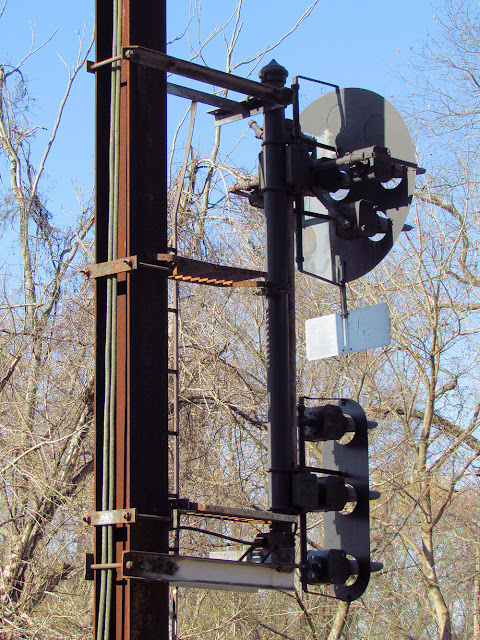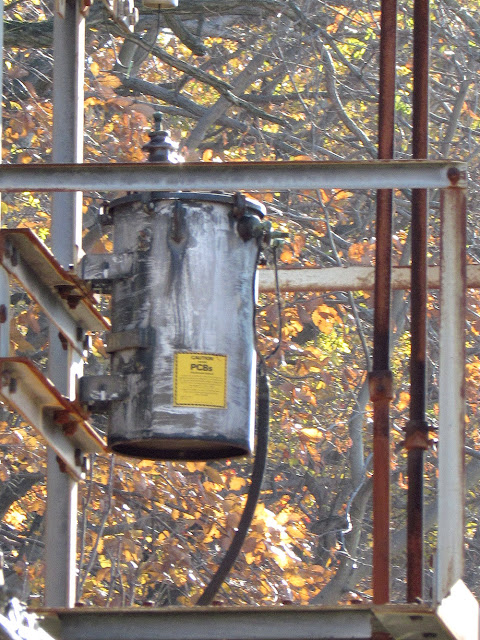The 218R signal is mounted on a surviving full height catenary support, instead of the chopped down poles seen at CP-WEST PILOT and CP-MIDWAY.. As this siding is fully signaled, the 218L is equipped with a lower head able to display Medium Clear and Medium Approach. Stop and Proceed takes the place of Restricting so no lower head \ position is provided.
In this rear quarter view of 218 L one can see where the fresh new paint has and has not been applied. From the condition of the signal cable that does not appear to have been replaced. These photos were taken in 2011.
Like the MIDWAY and the PILOTs, the relay hut at CP-WEST ROCK is the original PRR equipment and spots a fresh coat of temperature reducing silver paint. Behind the hut is an auxiliary cabinet for relays and other equipment. The Conrail blue interlocking signs have also been retained. The official milepost of the interlocking, 7.5 from Perryville, is stenciled on the hut door. If you are wondering where the "pole line" satellite dish is, it is mounted across the tracks on an old catenary post.
The westbound signals are mounted on a typical two-track catenary gantry modified to support signals. The signals were controlled by a single lever (218) on the old COLA machine with 218RA on the main track and 218RB on the siding.
The 218RA is a single upper PRR PL head that has had the lower Stop and Proceed marker removed in the refurbishment. You can also see the fabric insulated signal cables that were not changed in the refurb. The shiny screws on the freshly painted face of the PL however, were replaced.
The 218LB signal is typical for what one sees when exiting siding tracks with a Stop only upper head and a lower head supporting Medium Clear and Medium Approach. The lamps are bright and well focused, a problem with US&S pattern PRR PLs, which use a complex lens and parabolic mirror system to focus the output from the low power bulbs.
The intermediate signal between CP-WEST ROCK and CP-TOME is located around MP 6.5 with the eastbound signals bearing the plate C64 and the westbound signals C65. According to the interlocking chart this signal location is known as "Rock" (explaining why CP-WEST ROCK is CP-WEST ROCK), but I have no additional information about the history of the name. The signals are mounted on a modified catenary gantry with the eastbound siding signal mounted on a mast position to the right of its track. Here in this Feburary 2011 photo we see both C64 signals displaying an Approach indication for a Stop at CP-TOME.
As the siding is only two blocks long the best indication available on the C64-1 signal governing eastbound traffic on the siding is Approach Medium. The "Rock" siding is popular for NS to store high and wide trains before they are admitted to the NEC due to a a length of track between here and CP-TOME with larger than normal track centers.
Here in this 2012 view we can see that the refurbishment painting applied to the entire signal structure, unlike the job performed at CP-WEST ROCK.
Without a diverging movement at CP-TOME the main track signal is a typical 3-aspect PRR PL head, shown here displaying Approach. The "cage" for a lower head is nevertheless provided, which implied that the electric territory mountings were prefabricated without regard to context.
The westbound C65 signals located on the same structure and mirror the eastbound signals. One reason the PRR not have "combination" indications such as Medium Approach Medium was that they made an effort to not to have single block signaled sidings. The C6x signals are located midway along a 3-mile sidings creating two shorter than normal signal blocks. Today a modern railroad would have most likely made the siding a single block. Note the end of a empty autorack train heading westbound on the siding track after delivering its cargo to the Port of Baltimore. The photo was taken early on a Saturday morning as the last of the freight traffic was being hustled off the NEC.
At some point between 2005 and 2011, the -1 suffix was added to the siding signals at the MP 6.5 location.
The approach indication on the main track signal indicates that the westbound autorack train will probably be getting an Medium Clear at CP-WEST ROCK. Note the un-refurbished cotton insulated signal cable.
Here we see the out of service power supply for the MP 6.5 intermediate signal. All the valuable copper 100hz 6kv power cable was removed by NS, leaving the insulators and transformer behind.
If you are wondering why so much out of service hardware was left behind the big yellow PCB sticker might shed some light on the topic.
Across the tracks is the battery case and pole line tap for the intermediate signals. I suspect the pole line was still in service for block signal status. The small relay cabinet is for the road crossing logic as was demonstrated for me in 2011 when the gates were stuck down for an MoW crew.
The same worker who was nice enough to manually disable to games was cool enough to pop open the relay hut and give me a view of the 1930's vintage signaling logic. I only got this one photo due to where the NS C&S workers was standing. There was one new piece of hardware and that was a replacement power supply, now fed from the local utility supply. Power for CP-WEST ROCK also originates from this location being transmitted to the interlocking site via a mile long burred 480v cable.
What was the MoW crew doing? Removing the long disused catenary poles for scrap value :-(
The eastern end of the "Rock" siding is at CP-TOME. This interlocking is housed in a concrete bungalow the same as those seen in the COLA interlocking complex at PORT, LAKE, SHOCKS and MANOR. The old concrete box has been spruced up with a snazzy new satellite dish, a conversion which probably phased out the rusty old interlocking telephone box. CP-TOME was remote to COLA, just like CP-WEST ROCK and the others, but marks the southern end of COLA's zone of control.
The eastbound signals at CP-TOME are something quite special. TOME is back-to-back with CP-QUARRY, about 1 mile to the east. As a result we see the 206LA sporting a full upper head combined with a lower head featuring a | position for Approach Limited (CP-QUARRY has a Limited Speed turnout) and a \ for Restricting. Also note how the upper head uses N&W style PL units with the short sun shades. Compare to the lower head which uses the more typical PRR variety. This might be one way to tell between a US&S PL-2 and PL-3 position light lamp, but I am not 100% sure of this.
The 206LB siding signal is even more interesting. Because the PRR did not support Medium Approach Medium, trains could diverge over Approach Medium or Approach Limited as long as the preceding signal gives the train appropriate warning of the diverge.Since trains coming off the Rock siding could then diverge at CP-QUARRY, the 206LB signal is equipped with an / position on the upper head along with a full lower head to allow for Approach Limited indications in addition to the more typical Medium Clear, Medium Approach and Restricting. I also suspect that the back-to-back nature of the interlockings made Restricting indications available at no additional "cost" since the traffic control situation between two interlockings is much simpler than between a longer stretch of CTC track. Also note the brand new plastic wrapped signal cables.
Here is a rear view of the refurbished 206LB signal showing a new junction box fed by a thick grey cable and fresh shiny mounting screws.
CP-TOME is also unusually long, compared to the other interlockings on the Port Road. Here we can see the relative positions of the turnout and the relay hut.
Here is the TOME power supply post decommissioning and still equipped with its yellow flagged 100hz power transformer.
1000 feet east of the 206L signals is the 205 turnout which I believe is Medium Speed, but might be limited speed. This photo was taken in 2004 and shows a dual control US&S M23 point machine. I don't have many photos of this turnout because I'd have to stop the car an extra time on the way to the westbound home signal and I usually can't be bothered.
Another 1000 feet east of the turnout we finally find the westbound signal for CP-TOME. That's right, 2000 feet of interlocking limits all for a single switch. Here we see the 206R signal post refurbishment and post catenary pole removal in 2012. It is basically a clone of the 218L signal at CP-WEST ROCK with a full upper head and lower head able to display Medium Clear, Medium Approach and Stop and Proceed.
Here is a 2011 zoom shot showing the same 206R signal and the 205 turnout just before the catenary supports were removed. Note the signal refurbishment took place before the scrapping project.
Due to the distance between the eastbound and westbound signals, the 206R is equipped with its own relay cabinet. If my memory serves me correctly, back in 2004 when I first visited CP-TOME, all three cab signal generators were active even with a Stop signal displayed on the signal. In 2012 and 2011 the generators were inactive when code was not being pumped into the rails. I could certainly be mistaken, but this might have been another change with the refurbishment.
Well that's it for this episode of Port Road Trips. If you thought the name Columbia and Port Deposit implied the line ended here you would be wrong as it continues on to Perryville and Amtrak's Northeast Corridor.

































No comments:
Post a Comment